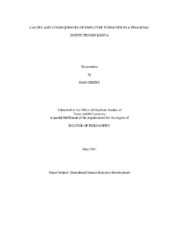| dc.description.abstract | Employee turnover is expensive and disruptive to organizations. However not many employers appreciate the value lost in quality of human capital, and dollar value of lost productivity and time due to turnover. This study identified the causes and consequences of voluntary employee turnover in a financial institution in Kenya. The researcher established from the bank records that 80 employees resigned from the institution in the five-year period. The causes of turnover were identified and recorded as given in the separated employees' resignation letters held at the bank, and categorized as either avoidable or unavoidable. The quality of the separated employees was measured by academic qualifications, banking training, job performance ratings and years of work experience as recorded in the separated person's file. Turnover cost was computed based on the earnings of the separated employee and the associated administration costs, plus the cost of training and lost productivity due to the resignations. The turnover policies were reviewed. The data collected were coded and analyzed using the SPSS program version16. The quantitative data analysis was carried out using descriptive statistics. Non-parametric Chi-Square Goodness-of-Fit Test was used to test the research hypotheses. A thematic analysis of the narration by the HR director was done.
The reasons for the resignations were as follows: 65 percent better salaries offered elsewhere, 17.7 percent were due to family reasons, 13.8 percent went on further studies, 2.5 percent had problems with bank administration and 1.2 percent changed careers. It was further established that 71 percent of the separated workers had university degrees, 92 percent were either good or excellent job performers, 35 percent had more than ten years work experience and 80 percent had received bank training. The turnover cost per separated employee was 100 percent of the worker's annual salary. The total turnover cost comprised of 43.5 percent in lost productively due to the resignations; 30.9 percent on training and 25.6 percent on recruiting and hiring replacements. The researcher concluded that personnel turnovers had negative consequences for the bank in terms of loss of quality human capital and cost, and that management should act to resolve the problem since 67.5 percent of the turnovers were avoidable. | en |


